INCREDIBLE INDIA

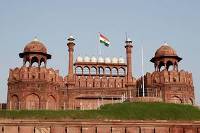
Red Fort Complex (Delhi)
Also known as Lal Qila is a palace fort built in the 17th century by Shahjahan (1628–58), the fifth Mughal Emperor as part of his new capital city of Shahjahanabad. Located to the north of Delhi.

Qutub Minar and it's Monuments
It is a complex with the Qutub Minar as the centre piece, which is a red sandstone tower of 72.5 metres (238 ft) height with a base of 14.32 metres (47.0 ft) reducing to 2.75 metres (9.0 ft) diameter at the top. Built in the beginning of the 13th century.

Humayun's Tomb (Delhi)
The first tomb built with several innovations, set at the centre of luxurious gardens with water channels, was the precursor monument to the Taj Mahal (built a century later). It was built in 1570.
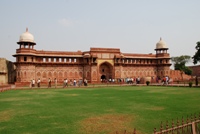
Agra Fort (Uttar Pradesh)
It is also known as the Red Fort of Agra, which represented Mughal opulence and power as the centre piece of their empire was inscribed in the UNESCO World Heritage List in 1982, as a cultural monument. The fortress located on the right bank of the Yamuna River, built in red sandstone, covering a length of 2.5 kilometres (1.6 mi) and surrounded by a moat, encloses several palaces, towers and mosques. These were built from 16th century onwards until early 18th century, starting with Emperor Akbar's reign in the 16th century to that of Aurangzeb in the 18th century.
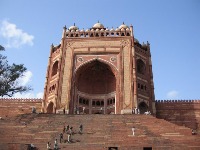
Fatehpur Sikri (Uttar Pradesh)
Literally "the City of Victory", was built during the second half of the 16th century by the Mughal Emperor Akbar (1556–1605). It was the capital of the Empire and seat of the grand Mughal court, but only for 14 years. Despite bearing exceptional testimony to the Mughal civilization at the end of the 16th century, it had to be abandoned due to the twin reasons of lack of water and unrest in north-west India, leading the Emperor to shift the capital to Lahore.

Taj Mahal (Uttar Pradesh)
One of the Seven Wonders of the World, it is a mausoleum – a funerary mosque. It was built by Emperor Shahjahan in memory of his third wife Begum Mumtaz Mahal who had died in 1631. It is a large edifice made in white marble in typical Mughal architecture, a style that combines elements from Persian, Islamic and Indian architectural styles.
Some of the people argue that Taj Mahal was Tejomahalaya ( Lord Shiva Temple and a Hindu Scientific and Cultural Complex). It was destroyed and turned into a grave by Shahjahan. There's strong evidence pertaining to this aspect including Vedic Architecture inside the Mahal. The term 'Mahal' was never coined in Islamic Literature. It is taken from Sanskrit Word "Mahaalaya - Huge Temple Complex". (Reference: http://www.stephen-knapp.com/was_the_taj_mahal_a_vedic_temple.htm)
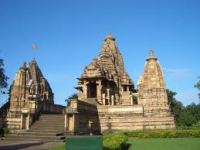
Khajuraho Group of Monuments (Madhya Pradesh)
This group is attributed to the Chandela dynasty which, under sovereignty of Gurjar Pratihars reached its glory between 950 AD and 1050 AD. The ensemble of monuments that have survived belong to the Hindu and Jain Religious practices with striking fusion of sculpture and architecture; the best example of this outstanding feature is seen in the Kandariya Temple . Of the 85 temples built, only 22 temples have survived in an area of 6sqkm, which represents the Chandela period of the 10th century.
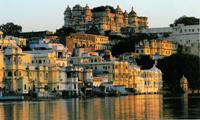
Udaipur
Udaipur is said to be India 's most romantic city, and it really is true! Who could resist the allure of its enchanting old mansions, beautiful gardens, intricate temples, and grand palaces overlooking expansive shimmering lakes. The City Palace , which stretches along the eastern shore of Lake Pichola , leaves visitors spellbound. The way it has been constructed is exquisite, with Rajput military architecture and Mughal style decorative techniques both combined together. The Mewar royal family still lives in a part of it too!
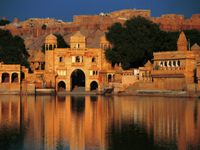
Jaisalmer
Jaisalmer is often referred to as being straight out of a romantic Arabian Nights fable. It's a cliche, but how better to describe this remarkable sandstone city that rises magically from the sand dunes of the Rajasthan desert? Jaisalmer's mesmerizing ancient fort, built in 1156, is perched high on a pedestal overlooking the city. Inside, the fort is vibrant and evocative. It houses five palaces, several temples, and some exquisite havelis (mansions), as well as shops and other residences. Staying inside the fort is an experience not to be forgotten.

Varanasi
One of the top 5 spiritual destinations in India, Varanasi is a sacred Hindu city with a very old history. Known as the city of Lord Shiva , the god of creation and destruction, it’s believed that anyone who dies here will be liberated from the cycle of reincarnation. Even a wash in the Ganges River is said to cleanse away all sins. The fascinating thing about this mystical city is that its rituals are revealed openly along the many riverside ghats. Staying at a hotel overlooking the Ganges is highly recommended and memorable.





